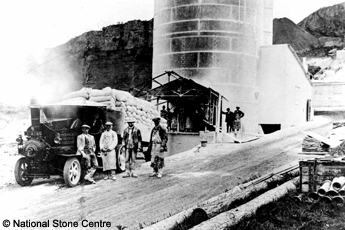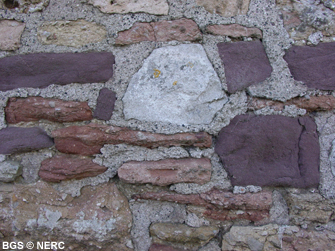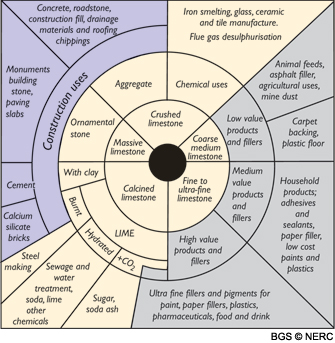
Quarrying
Stone as a resource
Uses of stone | Aggregate resources | Stone production
Uses of stone
When one thinks of stone, its use in famous buildings probably first comes to mind, but few people probably realise that stone in some form enters our lives probably a hundred times even before we leave the house each day. Five main groups of uses can be identified:
- Building and decorative stone – stone used for its resistance to weather or its aesthetic appeal – walls and decorative purposes. Buildings, walls, paving slabs.
- Aggregates – stone used for its strong physical properties – crushed and sorted into various sizes for use in concrete, coated with bitumen to make asphalt or used 'dry' as bulk fill in construction. Mostly used in roads, concrete and building products.
- Industrial purposes – limestone can be used for its chemical (mainly alkaline) properties as calcium carbonate (CaCO3) in farming and manufacturing industry.
- Lime burning (calcining) – limestone when heated to a high temperature breaks down into lime (calcium oxide) and carbon dioxide gas. It can then be used as a more powerful alkali than limestone (see above) or used as a cement with sand, to make mortar, or as a soil improver in agriculture.
- Cement – if limestone (or its variety chalk) is mixed with clay or sandstone before firing, it can produce Portland cement which when mixed with aggregate makes concrete.
Stone from Mendip quarries has been employed in all of these ways (with the exception of Portland cement manufacture).
Lime-burning

Until the 1920s, lime-burning, although small scale, was widespread. The remains of hundreds of small lime-kilns can be seen scattered across Mendip. Since the 1920s, lime burning has been concentrated at larger plants. Throughout the middle of the 20th century, Callow Rock and Gurney Slade quarries were the two main producers, by the 1970s both these had closed but a major new plant was established at Batts Coombe. The main purpose of this investment was to supply the South Wales steel industry at Llanwern and Port Talbot.
Aggregates
Aggregates represent about 98% of quarry output, most of which is used in road construction, maintenance and repair. Much of this goes to the production of asphalt, the remainder is used 'dry' without the addition of other materials to provide a sturdy base for roads. Some of the asphalt is processed in the area at or near the quarry, the rest is processed at remote plants. Only the harder more resilient rocks such as the Silurian andesite lavas from Moon's Hill can be employed for most road surfacing requirements. The harder Carboniferous Limestone aggregates are generally used in the lower layers of roads and in footpaths, car parks etc. but polish too readily (and hence have low resistance to skidding) to be used for road surfacing.
Apart from road usage, substantial amounts are mixed (coarse gravel sized stone with finer stone particles or sand) with cement and water to make concrete. This may be carried out at the quarry or materials supplied to truck-mixers (for mixing en route) or to remote plants. An important local 'downstream' industry is that of concrete product (blocks, pipes, kerbs, pavers, etc) with operations for example at Callow Rock, Mells, Torr Works, Holcombe, Wells and Cheddar. Not only do these produce 'added value' to the raw aggregate, they often make use of 'fines' which are a by-product of general aggregate processing, and without this market would often have to be dumped.
Non-aggregate and Industrial purposes
Only a very small amount (0.3–0.4 million tonnes annually) of Mendip stone is destined for non-aggregate and industrial purposes. In most instances, these are produced from those quarries, notably Batts Coombe and Callow Rock working deposits of very pure calcium carbonate limestones such as the Burrington Oolite. Uses include ground limestone for soil conditioning in agriculture, animal feed supplements (e.g. poultry grit) and latex treatment. Probably the largest single non-aggregate application is limestone utilised as a flux in steel-making.
Building stone

Today, the only building stone quarried on Mendip is Doulting Stone (Jurassic Inferior Oolite). In the past, small quantities of other materials have been worked as decorative stone and building stone, but the total quantity produced in any year in the past has probably never exceeded a few thousand tonnes and currently is only a few hundred tonnes.
The more important building stones are shown below:
| Local name | Geological name | Age | Location |
|---|---|---|---|
| Draycott Marble | Dolomitic Conglomerate | Triassic | Draycott and surrounding areas |
| Carboniferous Limestone | Carboniferous | Widespread local use | |
| Downside Stone | Lower Lias Group | Early Jurassic | North of Shepton Mallet |
| Chilcote Stone | Lower Lias Group | Early Jurassic | Horrington and Chilcote area |
| Doulting Stone | Inferior Oolite | Mid Jurassic | Doulting, Shepton Mallet |
| Bath Stone | Great Oolite Group | Mid Jurassic | Bath and Bradford on Avon |
- Home
- Overview maps
- Locality
areas
- Cheddar Gorge
- Charterhouse
- Blackdown
- Burrington Combe
- Shipham & Rowberrow
- Crook Peak & Axbridge
- Banwell to Churchill
- Priddy
- Harptree & Smitham Hill
- Draycott & Westbury-sub-Mendip
- Wookey Hole & Ebbor Gorge
- Wells
- Great Elm & Vallis Vale
- Mells & the Wadbury Valley
- The Vobster area
- The Whatley area
- Torr Works & Asham Wood
- Beacon Hill
- Stoke St Michael & Oakhill
- Holwell & Nunney
- Shepton Mallet & Maesbury
- Gurney Slade & Emborough
- The Nettlebridge valley
- Geology
- Minerals and mines
- Quarrying
- Caves and karst
- Biodiversity
- Detailed site information
- Acknowledgements
- External links
- Search
- Site map
